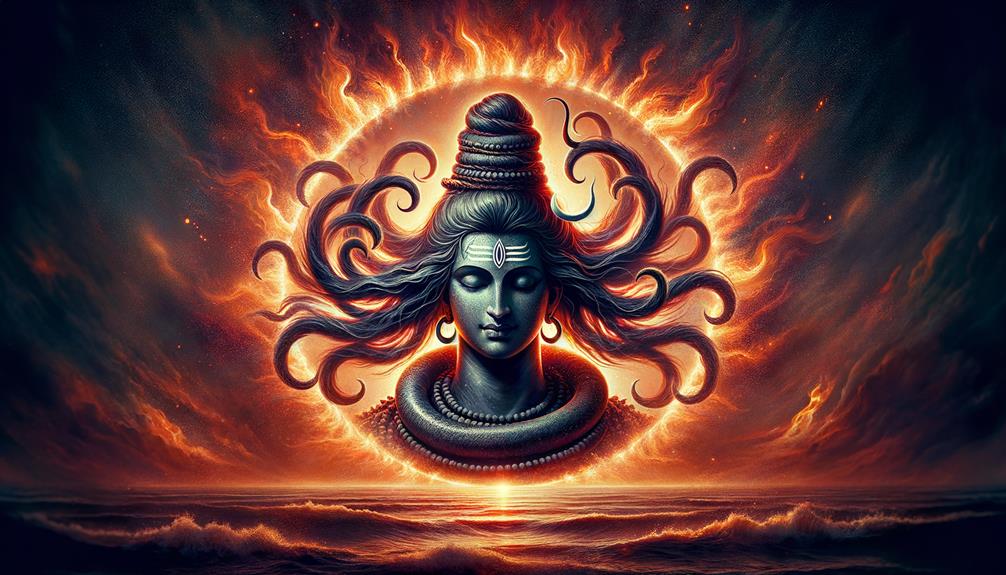The Cosmic Dance of Lord Shiva: A Deep Dive into Hindu Philosophy
Many people perceive dance as a form of self-expression or an obligatory routine at social gatherings. However, in Hindu mythology, dance takes on a far more profound meaning. Here, we explore the intriguing concept of Lord Shiva, the *Hindu deity celebrated as the cosmic dancer*. His rhythmic movements are believed to choreograph the intricate dance of creation and destruction within the universe.
Before you envision Lord Shiva swaying to Bollywood tunes, it's crucial to understand that his dance, known as the Tandava, embodies a profound spiritual and philosophical concept deeply rooted in Hinduism. To comprehend the symbolic complexity of Shiva's dance, we can compare it with other mythological representations of divine dances from various cultures. This comparison offers us a glimpse into the deep-seated messages hidden within these celestial performances.
So, what prompts Shiva's dance, and what does it represent? Unraveling this mystery provides a fascinating journey into the heart of Hindu philosophy.
Unveiling the Mystery of Shiva's Cosmic Dance
The dance of Lord Shiva isn't a simple physical act. Instead, it's a cosmic ballet, brimming with spiritual and symbolic significance. Delving deeper into these meanings, one can decipher life's profound truths embedded in Shiva's cosmic dance. The dance, therefore, isn't merely a performance but a cipher that, when decoded, reveals the wisdom of the universe.
By understanding the profound symbolism of Shiva's dance, we not only enrich our knowledge of Hindu mythology but also gain a broader perspective of cultural practices worldwide. Exploring these divine dances across cultures, we unearth the common threads of truth, wisdom, and spirituality woven into our shared human experience.
In conclusion, the dance of Lord Shiva in Hindu mythology is a fascinating subject that intertwines spirituality, philosophy, and cultural exploration. The cosmic dance transcends mere entertainment, embodying the cyclical nature of creation and destruction in the cosmos. This exploration invites us into a captivating world where mythology and philosophy converge, revealing the profound truths of life and the universe.
Discovering the mysteries of Shiva's dance is a journey worth undertaking, an exploration that offers a deeper understanding of not just Hindu mythology, but the shared spiritual heritage of humanity.
Understanding Shiva's Cosmic Dance

Unraveling the Depths of Lord Shiva's Cosmic Dance
To truly fathom the profound richness of Hindu mythology, one must get acquainted with the cosmic choreography of Nataraja, the dance avatar of Lord Shiva. This magnificent dance is not merely an artistic spectacle, rather, it artistically symbolizes the eternal wheel of creation, preservation, and dissolution. Shiva, as the lord of dance, is the pulsating energy that fuels all movement in the cosmos, manifesting the vibrant life force itself.
Shiva Nataraja: A Dance of Existence
The dance of the Hindu deity Shiva is a powerful metaphor, pivotal to comprehend the cyclic nature of life and the universe. The dance of Shiva Nataraja is far from just a figurative illustration. It is a divine ballet of the cycle of creation and destruction, staged on the cosmic platform. His dance styles, Lasya and Ananda Tandava, represent the softer and more energetic facets of this cosmic cycle, respectively.
Symbolic Elements in Shiva's Dance: Flames and Rivers
The symbolic features of Shiva's dance, such as the circular halo of flames and the holy river Ganges, further illuminate the interconnection between life and the cosmos. They collectively portray Shiva as the Creator, Preserver, and Destroyer. These symbols serve as a visual narrative, deepening our understanding of the cosmic dance and its significance.
Nataraja's Influence in Modern Hindu Culture
In today's Hindu culture, Nataraja's impact extends to being venerated as the god who envisioned the art of dance. The enduring relevance and adaptation of his image in contemporary society underscore his central role in Hindu mythology and culture.
To truly appreciate the depth and beauty of this cosmic dance, consider visiting the Chidambaram Nataraja Temple in Tamil Nadu, India. Not only will you witness the grandeur of the deity, but you'll also experience the rich tapestry of Hindu culture.
Symbolism in Shiva's Dance
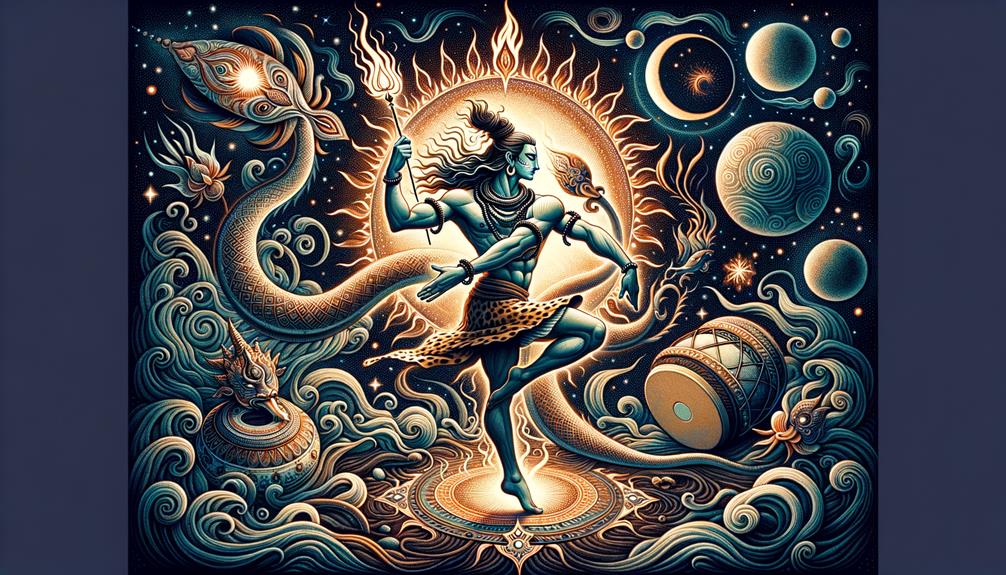
Unveiling the Profound Symbolism in Shiva's Cosmic Dance
To unravel the rich tapestry of symbolism in Shiva's dance, we must delve deep into the heart of Hindu mythology and universal philosophy. Shiva, as the Lord of the Dance, perfectly encapsulates the dynamic equilibrium of creation and annihilation through his movements.
Decoding the Elements of Shiva's Dance:
1. The Four Arms: A Cosmic Cycle and Cardinal Directions
Shiva's four arms are symbolic of the perpetual cycle of creation, preservation, and destruction. Additionally, they also stand as a metaphor for the four cardinal directions, hence symbolizing universal omnipresence.
2. The Right Foot: Triumph Over Ignorance
When Shiva's right foot stamps on the demon Apasmara, it is a clear representation of overcoming ignorance and ascending towards spiritual enlightenment. It's a powerful reminder of the transformative power of knowledge.
3. The Raised Left Leg: Emancipation from Mortal Chains
The raised left leg of Shiva signifies liberation. It symbolizes freedom from the recurring cycle of life and death, a concept deeply rooted in Hindu philosophy.
4. The Ring of Flames: Cosmic Energy in Balance
The flames encircling Nataraja, another name for Lord Shiva, symbolize the potent cosmic energy involved in the processes of creation and destruction. This ring of fire is a testament to the universe's rhythmic balance.
5. The Drum and Fire: The Universe's Rhythm and Transformative Destruction
Finally, the drum and fire Shiva holds play a key role in the symbolism of his dance. The drum embodies the universe's rhythm, while the fire represents the transformative power of destruction.
Understanding the symbolism in Shiva's dance provides a unique multi-dimensional perspective into Hindu mythology and the universe's workings. It's a beautiful blend of spiritual enlightenment and philosophical depth, which makes it a fascinating study.
History of Shiva as Nataraja
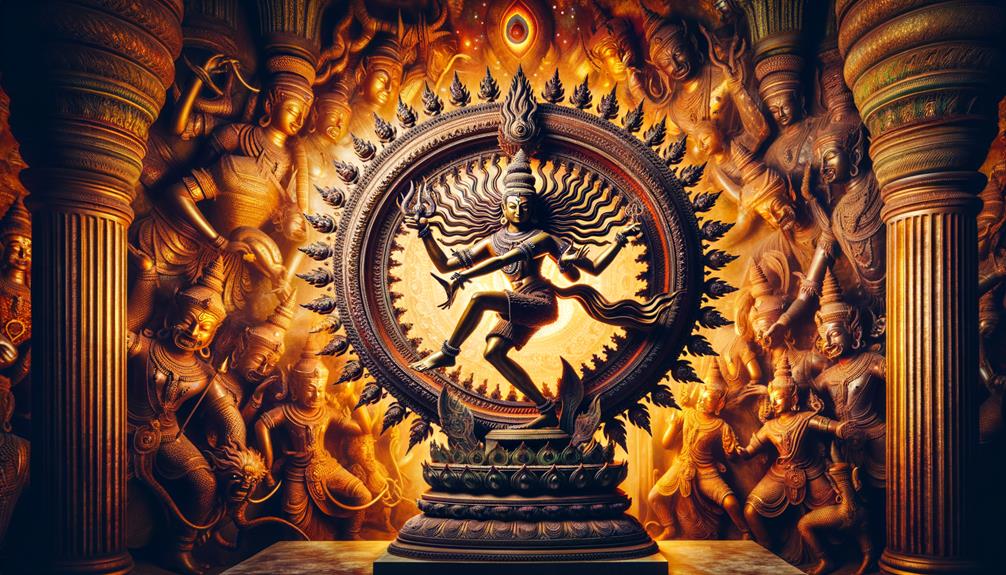
Unlocking the Mystical Legacy of Shiva as Nataraja
Dive into an enriching narrative that explores the genesis of Shiva as Nataraja, the cosmic dancer. This journey intertwines the vibrant threads of mythology, religious convictions, and the rich cultural tapestry of ancient India. The depiction of Shiva as Nataraja is a cornerstone of Hindu mythology, deeply anchored in age-old Hindu scriptures and customs.
Nataraja: A Symbol of Cosmic Cycles
The Dance of Shiva, encapsulated in the Nataraja figure, is a potent representation of the universe's cyclical pattern of creation and dissolution. This symbolism gained prominence during the Chola dynasty, an era known for its profound influence on Hindu Sculpture. The Shiva sanctuary in Chidambaram, Southern India, stands as a testament to this cultural legacy, housing the most venerated Nataraja statue.
Shiva as Nataraja: A Dance of Life
The portrayal of Shiva as Nataraja transcends mere dance. It is a profound declaration of life's rhythm and the cosmos' cyclical nature. This depiction is a visual manifestation of ancient Hindu philosophies and their comprehension of the universe's cyclical rhythm. Thus, the legacy of Shiva as Nataraja is not just a religious history chapter. It mirrors the complex interlacing of mythology, faith, artistry, and cultural ethos in the society of ancient India.
*"In essence, the history of Shiva as Nataraja is not just a chapter in religious history, but it reflects the intricate weaving of mythology, faith, art, and culture in the ancient Indian society."*
Delving into the history of Shiva as Nataraja is akin to unraveling the profound meanings embedded in the ancient Indian cultural and spiritual fabric. This narrative invites us to understand and appreciate the timeless wisdom and rich cultural heritage of ancient India. It's an engaging journey that's worth taking, as we gain insights into the intricate interplay of history, mythology, and faith that shaped this rich cultural tapestry. Embrace this journey for an enriching exploration of the cosmic dance of Shiva, the Nataraja.
Experience the mystique of the Shiva temple in Chidambaram, Southern India, which houses the most revered Nataraja statue. This sacred sanctuary is a vivid testament to the cultural legacy of the Chola dynasty and the profound influence of Hindu sculpture. A visit to this temple can provide a real-world example of the Nataraja legacy, bringing the dance of Shiva to life in front of your eyes.
Interpretation of Nataraja Artwork
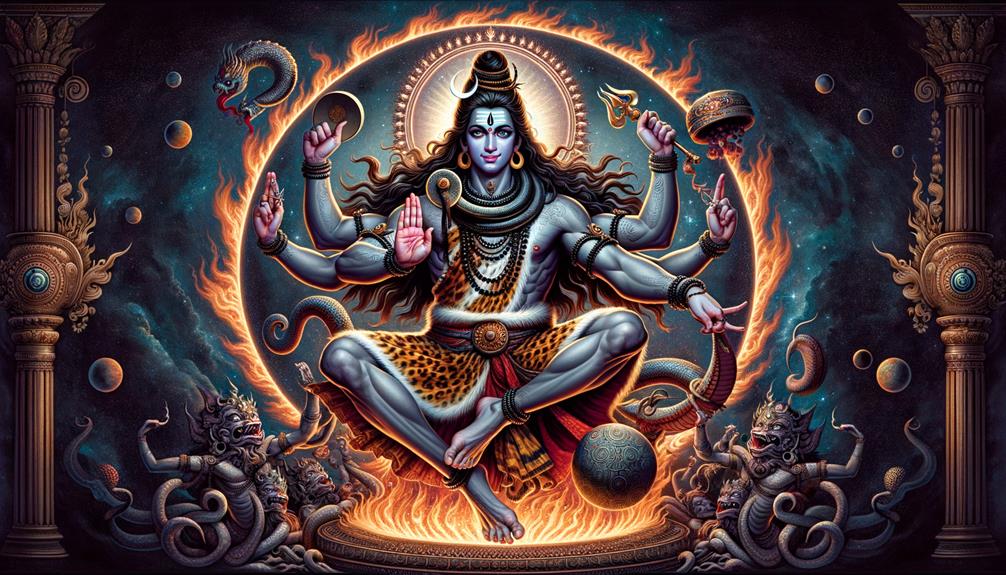
Unlocking the Mysteries of Nataraja Artwork
Embedded within the masterful depiction of Shiva, the celestial performer, the Nataraja artwork offers a treasure trove of symbols. Each intricate detail is an essential thread in this tapestry of the Lord of Dance and Dramatic Arts. Harking back to the Chola era, the statue of Nataraja captures the divine rhythm of Shiva's dance.
In this illuminating exploration of the Nataraja artwork, we will spotlight five pivotal elements:
- Shiva's Abhaya Mudra: This hand gesture is a beacon of fearlessness. It's Shiva's silent yet powerful message, emboldening us to face life's challenges without fear.
- The Crescent Moon: Nestled in Shiva's hair, the crescent moon is a poignant reminder of the relentless cycle of time, ever-changing yet eternal.
- The Ring of Fire: This fiery circle encapsulates the endless cosmic dance of creation and destruction, a stark reminder of life's transient nature.
- The River Ganges: Symbolizing rebirth, the river Ganges in the artwork signifies the ever-renewing cycle of life, a testament to the potential for transformation and renewal.
- Shiva's Dance: The rhythmic swirl of Shiva's dance mirrors the vibrant energy that powers the universe, a dynamic display of celestial choreography.
Far from being mere adornments, these elements hold profound philosophical and mythological significance. Each feature of the Nataraja statue is a pictorial embodiment of cosmic truths, reaffirming Shiva's paramount role in Hindu mythology. This artwork transcends the confines of Shiva temples, leaving its indelible mark on Indian dance and yoga.
The Nataraja artwork is more than a visual spectacle. It's an artistic prism refracting universal truths and timeless wisdom. Its influence is not confined to the spiritual realm but seeps into the fabric of Indian culture, shaping dance forms and yoga practices. Let's delve deeper into this fascinating world of symbolism and metaphor, where art meets philosophy.
Shiva's Influence in Dance and Yoga
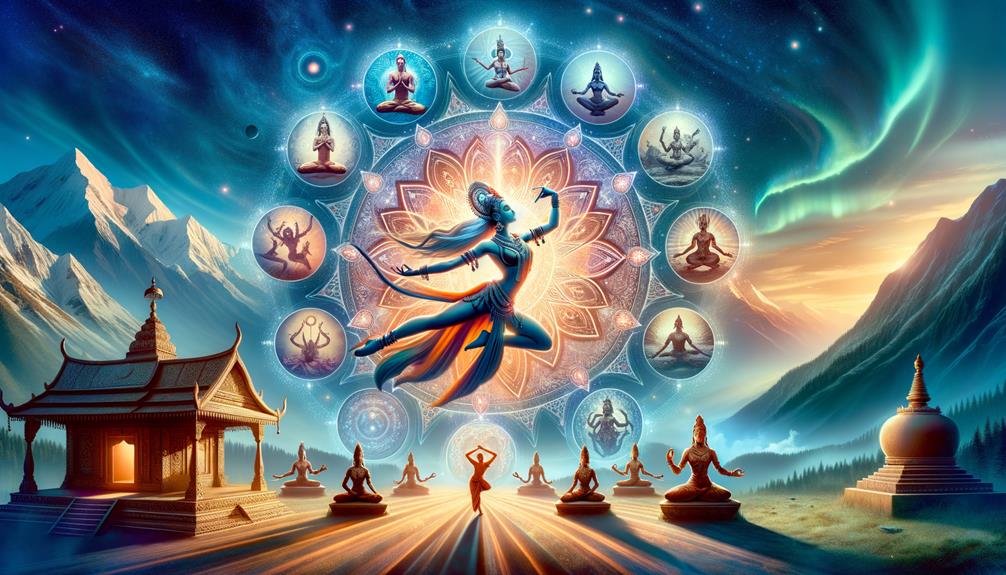
Shiva's Powerful Impact on Dance and Yoga
When delving into the considerable influence of Shiva in dance and yoga, the role of the Nataraja, embodying cosmic cycles of creation, preservation, and destruction, is unmistakable. This iconic figure's imprint is deeply etched into these ancient art forms. Acting as the lord of the dance, Nataraja performs within the cosmos, representing the perpetual flow of energy and interconnectedness. This 103rd avatar of Shiva holds an esteemed place in Hindu art, solidified by its presence in sacred sites like the Meenakshi Temple in Madurai.
The Nataraja sculpture's hand gestures, or mudras, in Hindu mythology, communicate profound meanings. One right hand grasps the drum of creation, another carries the flame of destruction, illustrating life's ceaseless cycle of birth and death. The dance also signifies assurance and protection, offering liberation from ignorance and a path towards enlightenment.
Shiva's influence extends beyond the spiritual sphere, shaping cultural phenomena such as classical Indian dance forms like Bharatanatyam, and yoga poses such as Natarajasana. This makes Shiva, the Hindu dance lord, an integral part of India's cultural and spiritual terrain.
Hand Gestures in the Nataraja Sculpture: A Deeper Look
Each mudra in the Nataraja sculpture is a rich tapestry of symbolism. The right hand, holding the drum of creation, sets the rhythm for the universe's birth. Another hand carries the flame of destruction, illustrating the constant cycle of life and death. The dance also symbolizes assurance and protection, a vehicle towards enlightenment and liberation from ignorance.
Shiva's Cultural Footprint: Dance and Yoga
Shiva's influence permeates more than just the spiritual world. His impact is visible in classical Indian dance forms such as Bharatanatyam and yoga poses like Natarajasana. This positions Shiva, the Hindu dance lord, as a central figure in India's cultural and spiritual landscape. Shiva's influence is a testament to the rich cultural heritage of India and is a fascinating study for enthusiasts of dance, yoga, and spirituality.
In Conclusion
Understanding Shiva's substantial influence in dance and yoga provides a window into the deep spiritual and cultural richness of India. The figure of Nataraja, symbolizing the cosmic dance of creation, preservation, and destruction, is a remarkable embodiment of the eternal flow of energy and interconnectedness. It's a journey of discovery that can inspire, engage, and transform your perspective on these ancient art forms.
Frequently Asked Questions
Why Is Shiva Called the Lord of Dance?
Understanding Shiva: The Cosmic Dancer
Are you curious about why Shiva, a revered deity, is often referred to as the 'Lord of Dance'? It's a fascinating concept that warrants a deeper dive. Shiva's dance is not just an artistic expression, but it represents cosmic phenomena in a captivating way.
The Cosmic Cycles: Creation and Destruction
Shiva's rhythmic dance movements are a metaphor for the Universe's cyclical nature. They represent the continuous cosmic cycles of creation and destruction. This is no ordinary dance; it's a dance of life and death, of beginnings and endings. It's a dance that highlights the transient nature of the world we live in.
Harmony and Balance: The Essence of Life
Shiva's dance also embodies harmony and balance, two crucial elements of existence. It's a powerful reminder that despite the constant changes, there is an underlying balance that keeps everything in place.
Shiva's Dance: A Real-world Example
To better understand this, let's take a real-world example. Consider the change of seasons: Spring brings birth and new beginnings, while Autumn signals decay and endings. Yet, both are essential parts of the natural cycle, and neither would exist without the other. Similarly, Shiva's dance symbolizes this constant flux and the inherent balance in the universe.
Recommendation
For those interested in learning more about Shiva, the Lord of Dance, we recommend reading "Dancing with Siva" by Satguru Sivaya Subramuniyaswami. It's an engaging and comprehensive guide that delves deep into the philosophical aspects of Shiva's dance.
Is Shiva the King of Dance?
Shiva: The Celestial Maestro of Dance
Absolutely, it's imperative to state emphatically that Shiva is revered as the supreme maestro of dance. This exalted title encapsulates his quintessential role in the continual cosmic dynamics of creation, preservation, and annihilation, visually embodied in his iconic dance, the 'Tandava'.
Shiva's dance isn't a mere performance. It's a powerful cosmic event, a divine spectacle that underlines his status as the universe's choreographer. His dance, the 'Tandava', is not just any dance; it's a symbolic whirl of energy, a divine manifestation of cosmic cycles.
Just as a dancer moves rhythmically to music, Shiva's Tandava symbolizes the harmonious oscillation of universal energies. It's the divine choreography that orchestrates the ebb and flow of the universe, a mesmerizing cosmic ballet that ensures the universe retains its rhythm and balance.
Shiva's dance isn't only about destruction. It's also about creation and preservation. It's a dance that celebrates the continuous cycle of creation, preservation, and destruction, a dance that encapsulates the eternal rhythm of the universe.
In conclusion, Shiva is indeed the celestial maestro of dance, a title that affirms his role as the divine orchestrator of the cosmic dance of creation, preservation, and destruction.
Who Is the Goddess of Dance in Hinduism?
The Enchanting Goddess of Dance in Hinduism: Saraswati
Delving into the rich tapestry of Hindu mythology, we find that Saraswati, the divine embodiment of knowledge, wisdom, and the arts, reigns as the revered Goddess of Dance. Her adeptness in the performing arts, particularly dance, leaves one in awe.
Saraswati's prowess is not confined to the terrestrial plane. Her influence permeates the cosmos, stirring the hearts of mortals and immortals alike. Her mastery extends beyond the realm of dance, spanning the universe of arts and knowledge. In the world of dance, she is a beacon of inspiration, guiding performers to reach their artistic zenith.
Saraswati: The Dance Maestro
As you delve deeper into the world of Saraswati, the magnificence of her realm unfolds. Saraswati's dance, a sublime blend of grace and power, personifies the profound wisdom embodied in the performing arts. Her dance is a metaphorical representation of the cosmic dance of creation, preservation, and dissolution – the eternal cycle of life.
Saraswati's Influence on the Performing Arts
Saraswati's influence on the performing arts transcends borders. For instance, in the classical Indian dance form of Bharatanatyam, performers often invoke her blessings for a successful recital. Her guidance is sought not just in dance but in all forms of art, underlining her pivotal role in the world of creativity.
In Praise of Saraswati
In the words of a renowned dancer, "Dancing under the divine guidance of Saraswati is like being carried by a celestial rhythm, a rhythm that transcends the mundane, connecting us to the infinite."
The fascinating world of Saraswati, the Goddess of Dance in Hinduism, beckons. Her unwavering commitment to the arts, her unparalleled wisdom and her profound influence on the performing arts make her a figure of reverence and admiration. She's more than a goddess; she's a beacon of light guiding us towards the pursuit of knowledge and the refinement of our artistic abilities. So, let's embrace her teachings and let the rhythm of creativity resonate within us!
Saraswati's world is truly a testament to the dazzling beauty of dance, the allure of creativity, and the power of knowledge.
What Is Shiva the God Of?
Shiva: The Versatile Deity and Cosmic Dancer
Shiva, a fascinating figure in Hindu mythology, dons multiple hats. His most recognized roles include being the deity of destruction and rebirth, yoga, and mediation. However, what truly sets Shiva apart is his cosmic dance, a striking representation of his dynamic nature.
Shiva: The God of Destruction and Rebirth
At the core of Shiva's multifaceted persona, he is celebrated as the god of destruction and rebirth. While this may sound disconcerting initially, it's worth noting that destruction, in this context, symbolizes the end of negative elements and the creation of positive change, leading to a cycle of rebirth. This unique aspect of Shiva offers a refreshing perspective on the concept of change, and how it can pave the way for new beginnings.
Shiva: The Divine Yogi
Shiva's influence doesn't stop there. He's also revered as the divine yogi, teaching the world about the power of yoga and meditation. Practicing yoga not only helps maintain physical fitness but also promotes mental tranquility. Thus, Shiva's teachings have implications far beyond the spiritual realm, extending to practical, real-world applications for health and well-being.
Shiva: The Cosmic Dancer
Now, let's delve into the most intriguing facet of Shiva – his embodiment as the cosmic dancer. This dance, known as the Tandava, symbolizes the rhythm and cycle of the universe. It's a dance of energy, a dance of life and death, a dance of creation and destruction. It's an embodiment of how Shiva is intertwined with the cosmic energy of the universe.
In conclusion, Shiva is a complex and fascinating deity. His roles are not just religious but offer deep insights into philosophy, life, and existence. Embracing the teachings of Shiva can lead to a balanced and enriched life.

